Flag of Afghanistan
 | |
| Use | National flag and ensign |
|---|---|
| Proportion | 1:2[1][2] |
| Adopted |
|
| Design | The Shahada in black on a white field in the calligraphic Thuluth script |
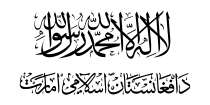 Variant flag | |
| Use | National flag and ensign |
| Proportion | 1:2 |
| Design | The Shahada in black on a white field, underneath which is "Islamic Emirate of Afghanistan" in Pashto, both written in calligraphic script |
The national flag of the Islamic Emirate of Afghanistan (Pashto: د افغانستان بیرغ; Dari: پرچم افغانستان[3]), adopted on 15 August 2021 following the Taliban's victory in the 2001–2021 war, features a white field with a black Shahada inscribed.[4][5][6][7][8][9] Since the 20th century, Afghanistan has changed its national flag several times.[10][11] The national flag had black, red and green colors most of the time during the period.
In contrast, the tricolor flag of the internationally recognized Islamic Republic of Afghanistan, still in use internationally and by internal resistance groups, consists of three vertical stripes in black, red and green, with the national emblem at the center in white. This emblem is encircled by sheaves of wheat and encompasses several elements: a Shahada, a Takbir, rays of the sun, a mosque with a mihrab and minbar, two miniature Afghan flags, the year 1298 in the Solar Hijri calendar (corresponding to 1919 in the Gregorian calendar), and the name of the nation. A version of this tricolor flag, introduced by King Amanullah Khan in July 1928, similarly featured three vertical stripes and an emblem within wheat sheaves.
Symbolism of the flag of the Islamic Emirate of Afghanistan
The current flag of the Islamic Emirate of Afghanistan is a plain white flag with the black words of the shahada in the centre. The white stands for "the (Islamic Movement of Taliban's) purity of faith and government"; the flag incorporated the shahada, the Islamic declaration of faith, after 1997.[12][13]
The current national flag differs from the banners of other jihadist groups, including those of al-Qaeda and the Islamic State, in having white as its chief colour and the shahada in black, an inversion of the design of the coloring of most jihadist groups' banners. This current Afghan flag likely was inspired by the historic Umayyad caliphate, which began the Muslim conquest of the Indian subcontinent, the Ghazwa-e-Hind: Islam entered Afghanistan with the Umayyad invasion, begun in 663–665 A.D. as a prelude to the Muslim conquest of Transoxiana from 673 to 751 A.D.
Islamic Republic tricolor
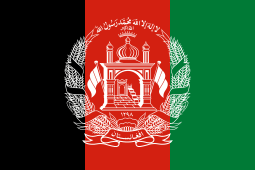 | |
| Use | National flag and ensign |
|---|---|
| Proportion | 2:3 |
| Adopted | August 19, 2013 |
| Design | Three vertical bands of black, red and green with the National Emblem in white centered on the red band and then slightly overlapping the black and green bands. |
 Variant flag containing a colored emblem | |
The national flag of the Islamic Republic of Afghanistan set out in the 2004 Constitution consists of a vertical tricolor with the classical national emblem in the center. The latest version was adopted on August 19, 2013, but many similar tricolor designs had been in use throughout most of the 20th century, starting in 1928. Due to the lack of diplomatic recognition of the Taliban government, this tricolor remains in use by most diplomatic missions of Afghanistan, despite the overthrow of the Islamic Republic in 2021. It is also used by the Afghan diaspora and republican insurgents, and is considered a symbol of resistance within the country.[14][15][16][17][18][19][20][excessive citations]
During the Afghan Independence Day rallies in Jalalabad and other cities on 18 and 19 August 2021, the Taliban killed three people and injured over a dozen others for removing Taliban flags and displaying the tricolor Afghan flags.[21][22] The Taliban has issued a decree requiring the use of the Islamic Emirate's flag in all official settings outlawing the tricolor.[4]
History of Afghanistan's tricolor flags
The black color represents its troubled 19th century history as a protected state, the red color represents the blood of those who fought for independence (specifically, the Anglo-Afghan Treaty of 1919), and the green represents hope and prosperity for the future.[23][24] Some have alternatively interpreted the black to represent history, the red to represent progress, and the green to represent either agricultural prosperity or Islam.[25][26]
The tricolor was supposedly inspired by the Afghan King Amanullah Khan when visiting Europe with his wife in 1928. The original horizontal tricolor design was based on that of the Weimar Republic-era flag of Germany.[27]
Almost every Afghan tricolor flag since 1928 has had the Emblem of Afghanistan in the center. Almost every emblem has had a mosque in it, which first appeared in 1901, and wheat, first appearing in 1928.
The last tricolor flag took its current form in 2002 with modifications later on in 2004 and 2013, with some variants containing differing coloured emblems.[28]
Following the restoration of the Islamic Emirate of Afghanistan after the Fall of Kabul in 2021, protests took place in Jalalabad and other cities, where protesters were seen waving Afghan tricolor flags protesting its removal in defiance of Taliban rule, due to the reinstatement of the white Shahada flag and the abolishment of the former black, red and green tricolor flag.[21]
The tricolor flag was used by the Afghan delegation at the 2020 Summer Paralympics between 25 August and 5 September 2021, as well as at the 2021 Cricket T20 World Cup between 26 October and 4 November 2021, both after the fall of Kabul.[29][30]
Historical flags
This article needs additional citations for verification. (January 2025) |
Black Standard in central Asia and the first flag
Black Standard is one of the flags flown by the Islamic prophet Muhammad according to Muslim tradition. It was historically used by Abu Muslim in his uprising leading to the Abbasid Revolution in 747 and is therefore associated with the Abbasid Caliphate in particular. The revolution began with a rebellion in Khorasan. After this event, in the world of Islam, black banners were strongly associated with Khorasan and the East in general.
The next dynasty associated with the use of the Black Banner was the Hotak dynasty in the early 18th century, following Mirwais Hotak's Sunni rebellion against the Twelver Shi'i Safavid dynasty. The flags of the Hotak dynasty are remembered as solid black, but sometimes there were also white shahada inscriptions.
The use of black banners is also attributed to the Principality of Qandahar.
Solid black flag was last used during the reign of Abdur Rahman Khan in the Emirate of Afghanistan and in 1901, after his death, a white seal was added to it.
Herat flag (1818–1842)
The Hotak dynasty was overthrown by Persian King, Nader Shah. Following his assassination in 1747, Ahmad Shah Durrani rose to power in Kandahar. He rapidly expanded into neighboring countries such as the Mughal Empire, Afsharids, and others. Ahmad Shah became the first Amir of modern Afghanistan (ruled 1747–1772). After the Durranis were deposed from power and forced to exile in Herat after the assassination of Fateh Khan Barakzai, the flag was implemented during the reign of Kamran Shah Durrani in the Emirate of Herat.
Second flag (1901–1919)
State flag and royal banner introduced around 1901, when Habibullah Khan ascended the throne, and replaced in 1919. Its use was limited to the king, the army and some state services (e.g. customs). Overlaid on a black field was a white emblem with a schematic drawing of a mosque, inside of which could be seen the mihrâb, a niche for prayer facing Mecca, and the minbar (pulpit). The mosque rested on crossed arms and weather vanes and was crowned with a royal headdress (Kolah namadi), all encased in a garland of leaves. The mosque has been used as a national emblem before, but its inclusion on the flag in 1901 is considered the first adoption of an official emblem. Since then, most of the later flags include the emblem.[31]
Third flag (1919–1921/29)
First flag flown under the rule of Emir Amanullah. He expanded his father's flag by removing the cannons and replacing the wreath with rays emanating from the seal in the form of an octagram. This new style of seal was common in the Ottoman Empire.
Fourth flag (1921–1926/29)
An oval replaced the circle inscribing the mosque in 1921. In 1926, Amanullah was proclaimed King and changed the national flag by modernizing the arms.[32]
Fifth flag (1926–1928)
After being crowned the first king of Afghanistan, Amanullah Khan replaced the star with a wreath, which, depending on the version, consisted of olive and oak leaves. The swords and kolah were removed from the emblem, and the mosque was redrawn to be more complex. Despite these changes, during King's trip to Europe in 1928, he was greeted with flags with star. In addition to changing the national flag, the king also introduced a personal flag, which contained elements removed from the emblem on a red background on the obverse and royal tughra on the reverse.
Sixth flag (1928)
Next flag flown under King Amanullah, introduced around June 1928. The Black Banner was replaced by the tricolor for the first time. Consisting of black, red and green respectively, symbolizing the past (previous flags), bloodshed for independence (Third Anglo-Afghan War) and hope for the future, it was probably influenced by the king's visit to Europe, and especially the Weimar Republic (which at the time had a black-red-gold flag) in 1927/8.
Seventh flag (1928–1929)
Fifth flag flown under the rule of Amanullah, introduced about a month after the last change. It was the first vertical-tricolored flag which would be used throughout most of the remainder of the 20th century. The emblem was completely changed in the style of socialist heraldry, removing religious, military and royal references. The new emblem shows the sun rising over two snow-capped mountains, representing a new beginning for the kingdom. This emblem also contained heaps of wheat, an icon that would be present on all future emblems of Afghanistan throughout different regimes. Notably, only the Soviet emblem had wheat at the time, and would in the future appear on many communist states' flags. The flag is known only through abbreviated descriptions; the chromatics of the central emblem are uncertain, as is the presence of the star. This short-lived innovative emblem did not appear on the currency. The symbol of the sun rising over the mountains appears later in the 1940s on the flag of Pashtunistan.
Eighth flag (1929)
In January 1929, in opposition to Amrullah's reformist rule, the Saqqawists approached Kabul. The king abdicated, leaving power to his brother. During the 3 days of his reign, Inayatullah Khan reportedly hoisted old flags with a solid black background.
Ninth flag (1929)
Flag used for several months in 1929 in areas not under Saqqawist control. During Amarullah's struggle to regain power the tricolor flag was restored however, in the center was the old radial emblem – with some modifications – in an elliptical version.
Tenth flag (1929–1931)
Saqqawist forces under Habibullāh Kalakāni established government of Emirate of Afghanistan on 17 January 1929. Flag flown under the brief rule of Habibullah Kalakani – a red, black and white vertical tricolor, like the ones used by the Mongols during their occupation of Afghanistan in the 13th century.[33] Saqqawist Emirate of Afghanistan controlled only part of Afghanistan, mainly around Kabul and a wide north–south strip along the border with British India, present-day Pakistan. The exception was the city of Herat, which was conquered in an uprising and held long after the fall of the Emirate and Kalakani's death.[34] The insurgents in Herat used a modified Saqqawi flag with a crescent moon.
Eleventh flag (1929)
Transitional flag used by Ali Ahmad Khan's short-lived rival government in Jalalabad, in opposition to the Kalakani rebellion.
Twelfth flag (1929–1931)
Direct development of the ninth flag under Mohammad Nadir Shah which retained the emblem in the star.
Thirteenth flag (1931–1973)
-
Royal standard of the King of Afghanistan (1931–1973)
-
Reverse of Mohammad Nadir Shah's royal standard (1931–1933)
-
Reverse of Mohammad Zahir Shah's royal standard (1933–1973)
The national and state flag, the longest existing in modern Afghanistan, adopted in 1930 and confirmed the constitution of October 1964. The flag was adopted under King Nadir Shah and survived his assassination on 8 November 1933 and lasted until the end of his son, Mohammad Zahir Shah's reign. The octagram rays were removed, and the seal enlarged – the mosque design is based on that of 1926. In between the mosque and the seal is the year ١٣٤٨ (1348 of the lunar Islamic calendar, or 1929 AD of the Gregorian calendar), the year Mohammed Nadir Shah's dynasty began. New royal flags were also introduced, which included the national emblem on a red background and new royal tughras on the reverse.
Fourteenth flag (1973–1974)
First flag flown for the Republic of Afghanistan, proclaimed after the 1973 Afghan coup d'état by the king's cousin, Army General Mohammad Daoud Khan, who became the first president. It is identical to the previous flag, except that the year ١٣٤٨ (1348) was removed as Zahir Shah's monarchy ended, this was probably not followed because of the poverty of the country, the low level of public construction and the family links between Daoud and King Zahir Shah.
Fifteenth flag (1974–1978)
Second flag flown for the Republic of Afghanistan. The same colors were used, but the meanings reinterpreted: black for the obscure past, red for blood shed for independence, and green for prosperity from agriculture. In the canton is a new seal, with a golden eagle with spread wings, a pulpit (minbar) on the eagle's chest (for a mosque), wheat surrounding the eagle, and the sun's rays above the eagle (for the new republic). The cartouche bears the name of the country and the date of the revolution according to the local solar calendar, 26 changash 1352, or 17 July 1973. President Daoud also changed the flag of the head of state by replacing it with a new emblem, and the flag became double-sided.
Sixteenth flag (1978)
When the republic's president Mohammad Daoud Khan was killed in a coup, the new regime under the People's Democratic Party of Afghanistan (PDPA) established a communist state. For a brief period of time, during the transition, the same flag design was kept, but no seal. A similar flag was used by the Junbish-e Milli party which controlled autonomous northern Afghanistan from 1992 to 1998.
Seventeenth flag (1978–1980)
A radical change, this flag used a red field with a yellow seal in the canton, a common design for socialist states in the 20th century. In fact, the design was very similar to the flag of the neighboring Soviet Union. It consisted of the PDPA's Khalq (Pashto: خلق, lit. 'masses' or 'people') faction's emblem with wheat, a star at the top (representing the five ethnic groups of the nation), the term 'Khalq' in Nastaliq script in the center, and a subtitle reading 'Saur Revolution ١٣٥٧' and the full name of the state. All religious references are gone.
Eighteenth flag (1980–1987)
Under the Fundamental Principles program of the new leadership under Babrak Karmal, the traditional black, red and green tricolor was re-established, representing the past, blood shed for independence, and the Islamic faith, respectively. A new seal was designed, with a rising sun (a reference to the former name, Khorasan, meaning "Land of the Rising Sun"), a pulpit and a book, ribbons with the national colors, a cogwheel for industry, and a red star for communism. The seal's ribbons and wheat has similarities to the then-East German and Romanian seals.
Nineteenth flag (1987–1992)
The flag was changed as part of Mohammad Najibullah's National Reconciliation constitution changes. Same as the previous flag, except that in the national seal, the cogwheel is moved from the top to the bottom, the red star and the book are removed, and the green field curved to resemble the horizon.
Twentieth flag (1992)
This flag was used as a provisional flag after the fall of the Najibullah pro-Soviet regime. It appeared in many variants of which two are shown here. The upper stripe contains the Takbir, whereas the center stripe (now white, with the red entirely removed from the flag) contains the Shahada.
Twenty-first flag (1992–2002)
-
7 December 1992 – 27 September 1996; 27 September 1996 – 27 January 2002 (Northern Alliance)
The new Islamic government under Rabbani featured a flag change. The color scheme is similar to several Middle Eastern Muslim nations' flags. Elements from the times of the monarchy returned to the emblem, but with the addition of the Shahada and drawn completely differently swords representing the mujahideen's victory. It now shows the year ١۲۹٨ (1298), the solar Islamic calendar equivalent of AD 1919 of the Gregorian Calendar, the year of full independence. On the bottom part of the emblem was written "دا افغانستان اسلامی دولت", Islamic State of Afghanistan. The rays of the rising sun have survived on the emblem. This pattern was used longer in areas that the Taliban did not control after winning the battle for Kabul, i.e. the north of the country. In 2021, the flag returned among the flags of the National Resistance Front of Afghanistan.
Twenty-second flag (1996–1997)
-
27 September 1996 – 26 October 1997[35]
A plain white banner was used by the Taliban.[35] In the Islamic tradition, the white banner is attributed to the Umayyad dynasty, which was overthrown by the Abbasids associated with black banners.
Twenty-third flag (1997–2001)
In 1997, the Taliban introduced the Arabic Shahada in black on a white flag as the national flag of the Islamic Emirate of Afghanistan.[35][36][37][2]
Twenty-fourth flag (2001–2002)
This flag was used by President Rabbani along with the national flag after the fall of the Taliban government. Same as the 1992 flag, but with Pashto and Dari texts.
Twenty-fifth flag (2002)
After the fall of the Taliban, the traditional black, red and green colors were restored and in a vertical pattern, just as the ones flown from 1928 to 1974. The center emblem is the classical emblem of Afghanistan – it is the same version as used in the 1992 flag, but with the swords removed.
Twenty-sixth flag (2002–2004)
The Loya Jirga of spring 2002 voted the Afghan national flag with some changes including the coat of arms being gold instead of white, the year now dating "1380" under the mosque instead of "1348". In June 2002, Afghanistan officially changed its national flag from a white coat of arms in the center of the flag to a gold coat of arms which symbolizes the colour of a wheat wreath.[28]
Twenty-seventh flag (2004–2021)
-
Standard of the president of Afghanistan (2004–2013)
-
Standard of the president of Afghanistan (2013–2021)
The 2004 constitution adopted under Hamid Karzai's presidency adopts an emblem more akin to the last emblem from the reign of the kingdom.[39][40] The flag was used in many variants by the Islamic State of Afghanistan, and after its collapse is one of the flags of the anti-Taliban opposition. In 2004, the flag of the head of state was introduced again, this time in opposite colors than the flag from the time of Daud. However, a newer emblem appeared only in 2013, when Karzai was replaced by Ashraf Ghani.
Twenty-eighth flag (2021–present)
In 2021, the Taliban re-introduced the flag of the Islamic Emirate. As with the first adoption of the Taliban flag, many variants appeared this time, among others, Shahada on a white flag with "Islamic Emirate of Afghanistan" in Pashto written below the Arabic Shahada;[41] a Dari Persian version of the flag has also been observed, although less frequently.
Unicode
The flag of Afghanistan is represented as the Unicode emoji sequence U+1F1E6 🇦 REGIONAL INDICATOR SYMBOL LETTER A and U+1F1EB 🇫 REGIONAL INDICATOR SYMBOL LETTER F, making "🇦🇫". However, the flag represented is still the one that belongs to the Islamic Republic of Afghanistan. Recent speculation state in future Unicode updates, the emoji will be updated.[42]
Gallery
-
Flags of Afghanistan on Koht-e Sangi during Independence Day
-
The Afghan flag flying at the Presidential Palace compound (2019)
-
Afghan children with the national flag in Badghis Province
-
Afghan children waving national flags in Helmand Province
-
Afghan flag hanging over the Afghan Embassy in Bonn, Germany
-
Afghan flags during the handover of Lashkargah (2011)
-
Afghan Border Police in Herat (2011)
-
Afghan refugees returning from Pakistan with an Afghan tricolor flag on their truck (2004)
-
Afghan, British and US flags on poles during a ceremony in Helmand Province (2010)
-
Flag similar to that of the 2002–2004 design being flown in Montréal, Canada.
-
Flags being flown during an anti-Taliban demonstration in Berlin, Germany (2021)
-
Vendor selling Islamic Emirate flags under Taliban rule (2021)
See also
Notes
- ^ a b c Remains in use in some contexts, mostly outside Afghanistan. See § Islamic Republic tricolor.
References
- ^ Smith, Whitney (1997). "New flags: Islamic Emirate of Afghanistan". The Flag Bulletin. XXXVI-5 (177).
- ^ a b "Amendments to the Flag and Emblem Law of the Islamic Emirate of Afghanistan". 20 September 1997. Archived from the original on 3 June 2019. Retrieved 21 August 2021.
- ^ "Afghanistan Flag". Flags Corner. 9 June 2016. Archived from the original on 17 November 2016. Retrieved 28 August 2019.
- ^ a b "Taliban hoist giant flag in Afghan capital, eight months after return". Agence France-Presse. Kabul. France 24. 31 March 2022. Archived from the original on 2 April 2022. Retrieved 4 April 2022.
- ^ Chughtai, Alia; Moslih, Hashmat (19 August 2021). "Infographic: Afghanistan's flags over the years". Al Jazeera. Archived from the original on 29 November 2021. Retrieved 4 April 2022.
- ^ Dawi, Akmal (14 March 2022). "Afghan Diplomatic Missions in US Close, Remain Open Elsewhere". Voice of America. Archived from the original on 31 March 2022. Retrieved 31 March 2022.
- ^ Gannon, Kathy (11 September 2021). "Taliban flag rises over seat of power on fateful anniversary". Associated Press. Kabul. Archived from the original on 9 October 2021. Retrieved 4 April 2022.
- ^ Bell, Stewart; Semple, Jeff (2 November 2021). "The Taliban is rebranding Kabul with its white flags, but what comes next has Afghans on edge". Global News. Retrieved 4 April 2022.
- ^ "Taliban flags proliferate as Afghan tricolour becomes resistance symbol". Agence France-Presse. Kabul. France 24. 23 August 2021. Archived from the original on 21 November 2021. Retrieved 4 April 2022.
- ^ "Afghanistan". The World Factbook. Central Intelligence Agency. 11 August 2021. Archived from the original on 4 January 2021. Retrieved 16 August 2021.
- ^ Artimovich, Nick; McMillan, Joe; Macdonald, Ian (21 September 2016). "Historical Flags (Afghanistan)". Flags of the World. Archived from the original on 4 July 2017. Retrieved 11 February 2020.
- ^ "The meaning and history of the Taliban flag amid protests in Afghanistan". inews.co.uk. 19 August 2021. Retrieved 30 May 2022.
- ^ "Black text on white background — the history and significance of the Taliban flag". ThePrint. 10 September 2021. Retrieved 30 May 2022.
- ^ Stancati, Margherita (18 January 2022). "Taliban Intensify Efforts to Take Control of Afghanistan's Overseas Embassies". The Wall Street Journal. Archived from the original on 24 January 2022. Retrieved 26 November 2022.
- ^ Jakes, Lara; Gall, Carlotta (13 February 2022). "Unpaid and Potentially Stateless, Afghan Diplomats Seek Permission to Remain in U.S." The New York Times. Archived from the original on 26 November 2022. Retrieved 26 November 2022.
- ^ "Flag of Afghanistan". CIA World Factbook. Archived from the original on 4 November 2023. Retrieved 26 November 2022.
- ^ Chabria, Anita; Parvini, Sarah (21 August 2021). "For many Afghan refugees, the struggles don't end when they reach U.S. soil". Los Angeles Times. Archived from the original on 26 November 2022. Retrieved 26 November 2022.
- ^ Wintour, Patrick (17 May 2022). "Plight of Afghan judges in spotlight as court hears UK asylum challenge". The Guardian. Retrieved 26 November 2022.
- ^ Robertson, Nic; Kohzad, Nilly; Lister, Tim; Regan, Helen (6 September 2021). "Taliban claim victory in Panjshir, but resistance forces say they still control strategic position in the valley". CNN. Archived from the original on 21 September 2021. Retrieved 26 November 2022.
- ^ "Taliban flags proliferate as Afghan tricolour becomes resistance symbol". Agence France-Presse. France 24. 23 August 2021. Archived from the original on 21 November 2021. Retrieved 26 November 2022.
- ^ a b Latifi, Ali M. "Shots fired at Afghan protest against Taliban, 2 reported dead". Al Jazeera. Archived from the original on 5 October 2023. Retrieved 19 August 2021.
- ^ "Several reported killed as Taliban shoot at crowds waving Afghan flag". The Guardian. 19 August 2021. Archived from the original on 26 March 2023. Retrieved 31 March 2022.
- ^ Smith, Whitney (25 March 2004). "Flag of Afghanistan". Encyclopaedia Britannica. Archived from the original on 10 August 2019. Retrieved 11 February 2020.
- ^ "Afghanistan Flag – colors & meaning – history & info". Facts.co. Archived from the original on 23 June 2018. Retrieved 31 December 2017.
- ^ "Field Listing :: Flag Description". The World Fact Book. Central Intelligence Agency. Archived from the original on 17 July 2017. Retrieved 11 February 2020.
- ^ Leitão, João. "Flags of Asia – Meaning of the Asian country flags". Nomad Revelations. Archived from the original on 3 October 2019. Retrieved 28 August 2019.
- ^ Healy, Don (1994). "Evolutionary Vexillography: One Flag's Influence in Modern Design" (PDF). Raven. 1. North American Vexillogical Association: 41–64. doi:10.5840/raven199415. ISSN 1071-0043. S2CID 183729827. Archived (PDF) from the original on 10 August 2019. Retrieved 11 February 2020.
- ^ a b "Afghanistan 2002–2004". www.crwflags.com. Archived from the original on 14 April 2006. Retrieved 18 June 2021.
- ^ "Afghanistan flag represented at Tokyo 2020 Paralympics Opening Ceremony". Tokyo 2020. Archived from the original on 7 October 2021. Retrieved 10 September 2021.
- ^ "Team Afghanistan – Profile | Tokyo 2020 Paralympics". Archived from the original on 7 October 2021. Retrieved 10 September 2021.
- ^ "Afghanistan". Archived from the original on 17 July 2023. Retrieved 17 July 2023.
- ^ Sache, Ivan (12 April 2002). "Afghanistan 1921 – 1926 or 1928". Flags of the World. Archived from the original on 24 August 2021. Retrieved 16 February 2022.
- ^ "Afghanistan January 1929 – October 1929". fotw.info. Archived from the original on 10 August 2019. Retrieved 28 August 2019.
- ^ Ali, Mohammed (1933). Progressive Afghanistan. Punjab Educational Electric Press. pp. 65, 66.
- ^ a b c d e f Lohlker, Rüdiger, ed. (2013). Jihadism: Online Discourses and Representations (PDF). Studying Jihadism. Vol. 2. V & R unipress GmbH. p. 44. doi:10.14220/9783737000680. ISBN 978-3-8471-0068-3. Retrieved 24 April 2022.
the Afghan Taliban used a plain white flag between 1996 and 1997 and a white flag with the Islamic credo in black letters from 1997 on until today.
- ^ "Home". Taleban New York Office. Archived from the original on 2 December 2000. Retrieved 24 April 2022.
- ^ "Flag and Emblem Law of the Islamic Emirate of Afghanistan" (in Pashto). Afghanistan Center at Kabul University. pp. 6–7. Archived from the original on 18 August 2022. Retrieved 24 April 2022.
- ^ a b c "Official Current Flag of Afghanistan". 19 March 2018. Archived from the original on 27 June 2022. Retrieved 13 April 2022.
- ^ "Afghanistan since August 2021". www.crwflags.com. Archived from the original on 17 October 2000. Retrieved 7 March 2023.
- ^ "Afghanistan January 2004 to August 2021". www.crwflags.com. Archived from the original on 1 April 2023. Retrieved 7 March 2023.
- ^ "Taliban flags proliferate as Afghan tricolour becomes resistance symbol". France24. 23 August 2021. Archived from the original on 21 November 2021. Retrieved 23 August 2021.
- ^ "🇦🇫 Flag for Afghanistan Emoji". Retrieved 20 December 2024.
External links
- National symbols of Afghanistan
- Flags of Afghanistan
- Flags introduced in 1901
- Flags introduced in 1919
- Flags introduced in 1926
- Flags introduced in 1928
- Flags introduced in 1929
- Flags introduced in 1931
- Flags introduced in 1974
- Flags introduced in 1978
- Flags introduced in 1980
- Flags introduced in 1987
- Flags introduced in 1992
- Flags introduced in 1996
- Flags introduced in 2001
- Flags introduced in 2002
- Flags introduced in 2004
- Flags introduced in 2021
- Flags representing the Shahada
- National flags




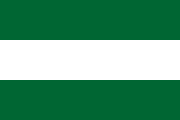








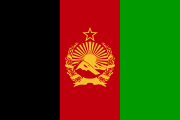
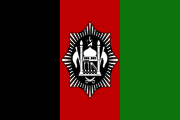
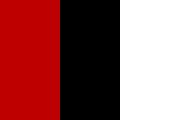



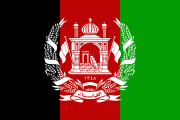






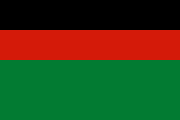






![27 September 1996 – 26 October 1997[35]](http://upload.wikimedia.org/wikipedia/commons/thumb/e/eb/Flag_of_Taliban_%28original%29.svg/180px-Flag_of_Taliban_%28original%29.svg.png)
![27 October 1997[35] – 13 November 2001](http://upload.wikimedia.org/wikipedia/commons/thumb/5/5c/Flag_of_the_Taliban.svg/180px-Flag_of_the_Taliban.svg.png)
![27 October 1997[35] – 13 November 2001](http://upload.wikimedia.org/wikipedia/commons/thumb/b/b1/Flag_of_the_Taliban_%28Shahada_v2%29.svg/180px-Flag_of_the_Taliban_%28Shahada_v2%29.svg.png)
![27 October 1997[35] – 13 November 2001](http://upload.wikimedia.org/wikipedia/commons/thumb/0/06/Flag_of_the_Taliban_%28Variant%29.svg/180px-Flag_of_the_Taliban_%28Variant%29.svg.png)



![August 19, 2013[38] – 15 August 2021[a]](http://upload.wikimedia.org/wikipedia/commons/thumb/c/cd/Flag_of_Afghanistan_%282013%E2%80%932021%29.svg/180px-Flag_of_Afghanistan_%282013%E2%80%932021%29.svg.png)
![9 October 2004[38] – 15 August 2021[a]](http://upload.wikimedia.org/wikipedia/commons/thumb/5/5f/Flag_of_Afghanistan_%28Colored_Emblem%29.svg/180px-Flag_of_Afghanistan_%28Colored_Emblem%29.svg.png)
![9 October 2004[38] – 19 August 2013[a]](http://upload.wikimedia.org/wikipedia/commons/thumb/3/3f/Flag_of_Afghanistan_%282004%E2%80%932021%2C_variant%29.svg/180px-Flag_of_Afghanistan_%282004%E2%80%932021%2C_variant%29.svg.png)














